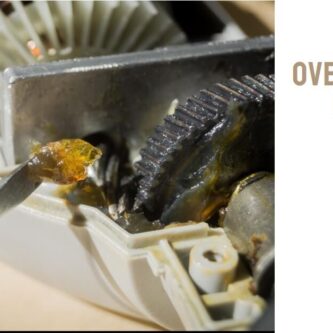Ceiling fans are essential fixtures in many homes, providing comfort and ventilation during hot weather.
Like any other electrical device, they require the right amount of voltage to operate efficiently.
However, some homeowners may not be aware that low voltage can damage their ceiling fans, causing costly repairs or even replacement.
Low voltage can damage ceiling fans and cause several problems, including slow or erratic motor operation, reduced airflow, and ventilation, overheating and burnout of motor components, excessive noise or vibration, inefficient energy consumption, and increased risk of electrical fires.
In this article, we’ll explore the effects of low voltage on ceiling fans and how to prevent damage from occurring.
What is Low Voltage?
Low voltage refers to electrical power that is lower than the standard voltage levels for a particular electrical system.
In the United States, the standard voltage for residential homes is 120 volts, while industrial and commercial facilities use 277 volts or higher.
Low voltage is typically defined as anything below 110 volts for residential applications.
Read my comprehensive article: Voltage Drop: The Silent Culprit Behind Electrical Fires.
How Ceiling Fans Work
Ceiling fans work by circulating air in a room, creating a breeze that can help lower the temperature and increase comfort.
They typically consist of a motor, blades, a mounting bracket, and other components that help regulate speed and direction.
The motor is the heart of the ceiling fan, responsible for converting electrical energy into mechanical energy to rotate the blades.
The right amount of voltage is crucial to ensure that the motor runs smoothly and efficiently.
Effects of Low Voltage on Ceiling Fans
Low voltage can cause several problems for ceiling fans, affecting their performance, longevity, and safety. Some common symptoms of low voltage damage include:
- Slow or Erratic Motor Operation: The motor is the heart of the ceiling fan, responsible for converting electrical energy into mechanical energy to rotate the blades. If the voltage is too low, the motor may not receive enough power to operate at its optimal speed. As a result, the fan may operate slowly, erratically, or may not turn on at all.
- Reduced Airflow and Ventilation: Ceiling fans work by creating a breeze that circulates air in the room, providing ventilation and comfort. If the voltage is too low, the fan may not generate enough airflow to effectively cool the room, reducing its efficiency.
- Overheating and Burnout of Motor Components: When a ceiling fan runs at low voltage, it has to work harder to operate, which can cause the motor components to overheat and burn out. Overheating can lead to costly repairs or even replacement of the motor, which can be a significant inconvenience for homeowners.
- Excessive Noise or Vibration: When a ceiling fan operates at low voltage, it may produce excessive noise or vibration, which can be annoying and distracting. This noise can be caused by the fan blades moving out of balance due to the reduced speed or other motor components working harder to compensate for the low voltage.
- Inefficient Energy Consumption: When a ceiling fan operates at low voltage, it consumes more energy than it should. This inefficiency can lead to higher electricity bills and wasted energy, which is not only bad for the environment but also for your pocket.
- Increased Risk of Electrical Fires: When a ceiling fan operates at low voltage, it can cause the electrical components to overheat, which can increase the risk of electrical fires. Electrical fires can be dangerous and can cause extensive damage to your home, putting you and your family at risk.
These issues can lead to costly repairs or replacement of the ceiling fan, which can be a significant inconvenience for homeowners.
In some cases, low voltage damage can also pose a safety hazard, especially if the fan is left running unattended.
Read also my article: Is Voltage Drop Killing Your Refrigerator? Here’s What You Need to Know
Keep You Ceiling Fans Working Efficiently
To prevent low voltage damage to ceiling fans, it’s important to take a proactive approach to maintenance and care. Here are some tips to help you protect your ceiling fan:
- Regularly inspect the fan’s wiring and components for signs of wear, damage, loose connection, or corrosion.
- Ensure that the fan is installed correctly and securely, with proper wiring and grounding.
- Use a voltage stabilizer or surge protector to regulate the voltage and protect against power fluctuations or surges.
- Keep the fan clean and free of dust or debris, which can reduce efficiency and increase wear and tear.
- Follow the manufacturer’s guidelines for maintenance and care, such as lubricating the motor and cleaning the blades regularly.
- Using an undervoltage protection device at your home is an effective way to prevent low-voltage damage to ceiling fans. This device regulates the voltage and protects against power fluctuations or surges, ensuring that your ceiling fan operates at its optimal voltage level. By installing an undervoltage protection device, you can protect your ceiling fan as well as all your appliances from low-voltage damage and extend its lifespan, saving you money on repairs and replacements in the long run.
By following these tips, you can help ensure that your ceiling fan operates smoothly and efficiently, without suffering from the effects of low-voltage damage.
conclusion
In summary, low voltage can damage your ceiling fan, leading to reduced performance, increased energy consumption, and safety risks.
However, with proper maintenance, care, and voltage regulation, you can protect your ceiling fan from low-voltage damage and enjoy its benefits for years to come.
Regular inspections, correct installation, voltage regulation, cleaning, and proper maintenance are all essential to ensure that your ceiling fan works optimally and safely.


